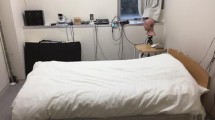Abstract
There may be a relationship between sleep and pain in patients with chronic back pain. We collected day-time pain and nighttime activity data from 18 patients diagnosed with chronic back pain. The patients were followed for 6 days and 5 nights. Pain levels were collected every 90 min between 0800 hours and 2200 hours using a computerized electronic diary. Activity levels were collected using a wrist accelerometer (Actiwatch AW-64). The Actiwatch sampled activity counts every 1 min. Patients were asked to wear the Actiwatch on their non-dominant arm.
The pain level measurements were interpolated using cubic splines. A mean pain level was calculated for each period 0800 hours to 2200 hours as well as for the 6-day period. The difference between the mean pain levels for the 6-day period and each 0800 hours to 2200 hours period was calculated for each patient. Nighttime activity data were analyzed using the Actiwatch Sleep Analysis software.
Correlations were calculated between the Actiwatch Sleep Analysis variables and the mean pain level differences for each patient and period. The correlation analysis was performed with SPSS 7.5. We were unable to show any significant relationships.
A different approach to analyze the data was used. A Self-Organizing Map (SOM) Neural Network was trained using the original nighttime activity level time series from 10 randomly selected patients. Recall was then performed on all the activity level data. Correlations were calculated between the pain level variance for the 6-day period for each patient and the corresponding difference in the SOM output coordinates. The correlation was found to be r = 0.73, p < 0.01).
We conclude that daytime pain levels are not directly correlated with sleep in the following night and that sleep is not directly correlated with daytime pain levels on the following day in this group of patients. There appears to be a correlation between the difference in nighttime activity levels and patterns and the daytime pain variance. Patients who experience large fluctuations in daytime pain levels also show a higher variability in their nighttime activity levels and patterns. Even though we were unable to show a direct relationship between daytime pain and sleep, it may be reasonable to assume that better pain control resulting in less daytime pain fluctuations can provide more stable nighttime activity levels and patterns in this limited group of patients. By using a neural network model, we were able to extract information from the nighttime activity levels even though a traditional statistical analysis was unsuccessful.
Similar content being viewed by others
References
Drewes AM, Svendsen L, Taagholt SJ, Bjerregard K, Nielsen KD, Hansen B. Sleep in Rheumatoid arthritis: A comparison with healthy subjects and studies of sleep/wake interactions. Br J Rheumatol 1998; 37: 71–81.
Lobbezoo F, Thon MT, Remillard G, Montplaisir JY, Lavigne GJ. Relationship between sleep, neck muscle activity, and pain in cervical dystonia. Can J Neuro Sci 1996; 23(4): 285–290.
Pilowsky I, Crettenden I, Townley M. Sleep disturbance in pain clinic patients. Pain 1985; 23: 27–33.
Wilson KG, Watson ST, Currie SR. Daily diary and ambulatory activity monitoring of sleep in patients with insomnia associated with chronic musculosceletal pain. Pain 1998; 75: 75–84.
Cole RJ, Kripke DF, Gruen W, Mullaney DJ, Gillin JC. Automatic sleep/wake identification from wrist activity. Sleep 1992; 15(5): 461–469.
Jean-Louis G, von Gizycki H, Zizi F, Fookson J, Spielman A, Nunes J, Fullilove R, Taub H. Determination of sleep and wakefulness with the actigraph data analysis software. Sleep 1996; 19(9): 739–743.
Jean-Louis G, von Gizycki H, Zizi F, Spielman A, Hauri A, Taub H. The actigraph data analysis software: I. A novel approach to scoring and interpreting sleep-wake activity. Perceptual and Motor Skills 1997; 85: 207–216.
Jean-Louis G, von Gizycki H, Zizi F, Spielman A, Hauri A, Taub H. The actigraph data analysis software: II. A novel approach to scoring and interpreting sleep-wake activity. Perceptual and Motor Skills 1997; 85: 219–226.
Jean-Louis G, Zizi F, von Gizycki H, Hauri P. Actigraph assesment of sleep in insomnia: Application of the actigraph data analysis software (ADAS). Physiol Behav 1999; 65: 659–663.
Jean-Louis G, Mendlowicz MV, Gillin JC, Rapaport MH, Kelsoe JR, Zizi F, Landolt H-P, von Gizycki H. Sleep Estimation from wrist activity in patients with major depression. Physiol Behav 2000; 70: 49–53.
Klimasauskas K. Neural Computing, A Technology Handbook. NeuralWare Inc. 1993.
Gabor AJ, Leach RR, Dowla FU. Automated seizure detection using a self-organizing neural network. Electroencephalogr Cli Neurophysiol 1996; 99: 257–266.
Kaartinen J, Hiltunen Y, Kovanen PT, Ala-Korpela M. Application of self-organizing maps for the detection and classification of human blood plasma lipoprotein lipid profiles on the basis of 1H NMR spectroscopy data. NMR Biomed 1988; 11: 168–176.
Kohonen T. Self-Organizing and Associative Memory. Springer-Verlag, 1989.
Pao YH. Adaptive Pattern Recognition and Neural Networks. Addison-Wesley, 1989.
Rosier EM, Iadarola MJ, Coghill RC. Reproducibility of pain measurement and pain perception. Pain 2002; 98: 205–216.
Giakas G, Baltzopoulos V. A comparison of automatic filtering techniques applied to biomechanical walking data. J Biomech 1997; 30: 847–850.
Golitschek MV, Schardt FW. Determination of transients and compensation capacities of breath-by-breath analysis by cubic splines. Med Eng Phy 1997; 19: 475–480.
Shirota A, Tamaki M, Hayashi M, Hori T. Effects of daytime activity on nocturnal sleep in elderly. Psy Cli Neurosci 2000; 54: 309–310.
Patterson SM, Krantz DS, Montgomery LC, Deuster PA, Hedges SM, Nebel LE. Automated physical activity monitoring: Validation and comparison with physiological and self-report measures. Psychophysiology 1993; 30: 296–305.
SPSS Version 7.5 Users Manual.
Author information
Authors and Affiliations
Rights and permissions
About this article
Cite this article
Liszka-Hackzell, J.J., Martin, D.P. Analysis of Nighttime Activity and Daytime Pain in Patients with Chronic Back Pain Using a Self-Organizing Map Neural Network. J Clin Monit Comput 19, 411–414 (2005). https://doi.org/10.1007/s10877-005-0392-8
Received:
Accepted:
Published:
Issue Date:
DOI: https://doi.org/10.1007/s10877-005-0392-8




